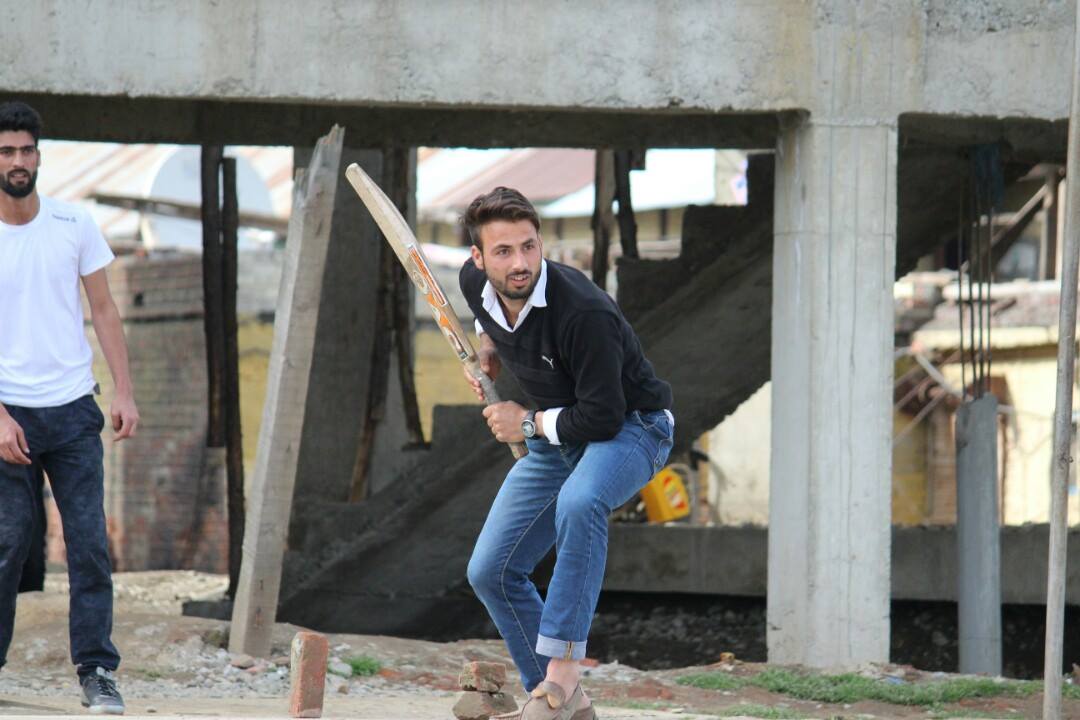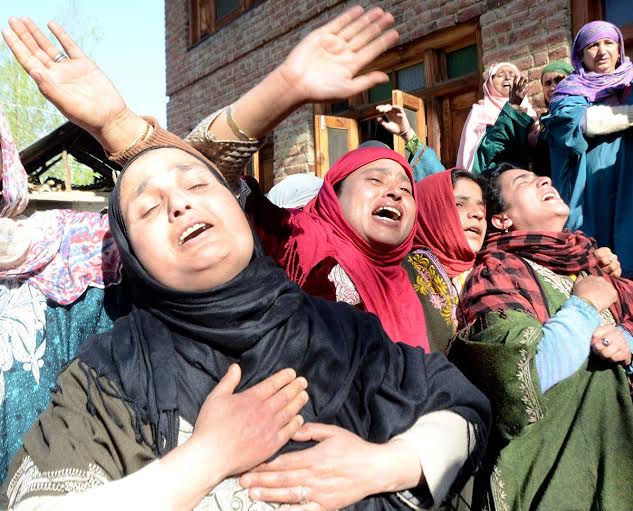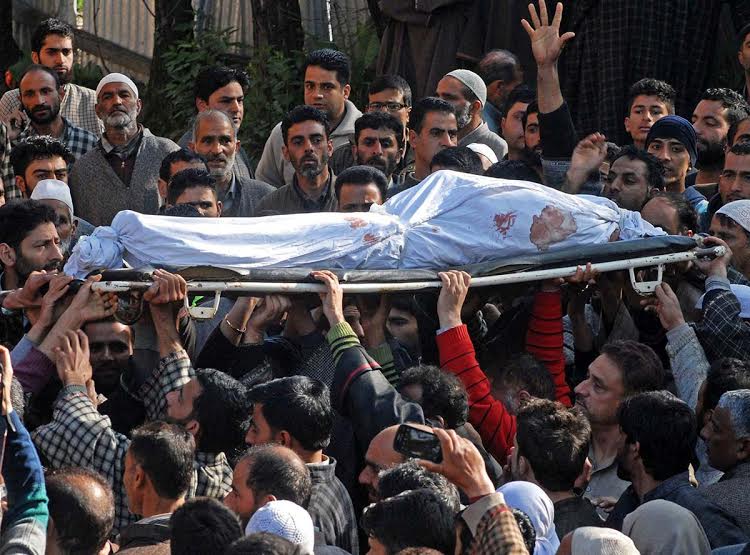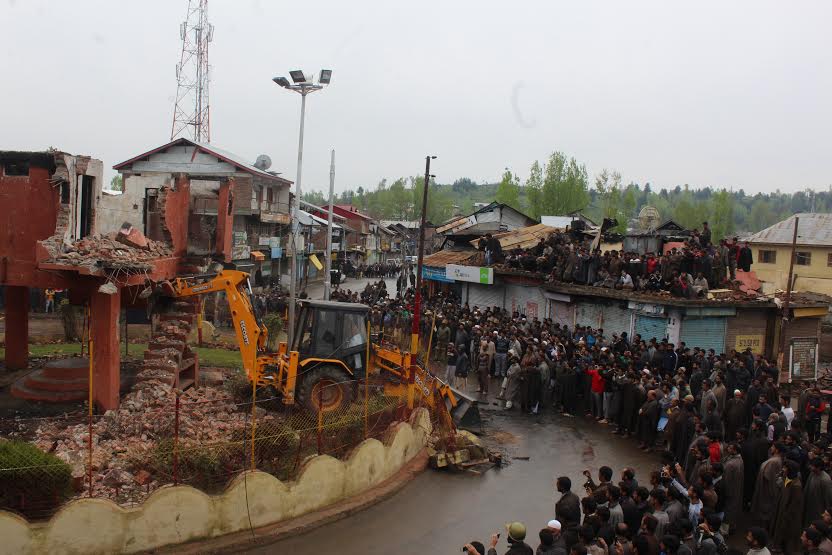Twenty six years after Handwara witnessed the first blood, two youth became the latest casualty, triggering a new chain of protests and killings in north Kashmir. Braving odds and obstructions, Bilal Handoo reaches Handwara to understand why angry youth lit the bunker that dominated the town, within hours after protesters cleaned the blood splattered main square

The unthinkable was almost on the cards. To restore the calm of Handwara, authorities had even agreed to allow burial of the slain youth in Handwara square, thus dislodging the barrel administration operating from the notoriously famous bunker there. It was supposed to be a big change, the town awaited since January 25, 1990—when the town’s tryst with ‘terror square’ began. But before the change could take over, the slain duo had long embraced their family graveyards.
On April 14, two days after forces sent four body bags to cemeteries, police had imposed strict curfew in Handwara to maintain “peace”. At various places, streets were raging with battles. The only unblocked route for Handwara was via Rafiabad. The picturesque countryside was apparently weighed under palpable grief in the air. Closer to Langate’s main market, near the house of the slain Raja begum, as soldiers showed their street signs, the grief became exceedingly blatant.
Inside, mourners were reticent, disturbingly silent. In the yard, occasional cries were shattering the uneasy calm. Tent pitched in the lawn was a packed house of women mourners. Beyond the house, soldiers had cut off the public movement. Some neighbours couldn’t make it to mourning. Those, who did, were worried about many issues.
“We are used to these curfews,” said an elder, “but I am worried about my chickens.” For the last two days, since curfew was imposed over the area, hundreds of his chickens were without water inside his locked down shop. He felt consumed by this guilt.
In the vast swathes of land, barely half a kilometre away, an army camp atop a hillock overlooks the belt. In late afternoon of April 12, Raja, the slain lady, was tilling her kitchen garden before gun shots rattled the still ambiance of the farmland, sandwiched between Handwara and Langate.
The protest had erupted 2km away in Handwara Chowk. Some locals could see soldiers resorting to firing from the hillock. It created panic around. But the 70-year-old Raja wasn’t as swift as others. As she was putting on her pheran to return home, a bullet pierced her skull from top and tore her brains in a flash before getting lodged inside her eye socket. She was evacuated brain dead and by the middle of that night, SKIMS declared her dead, formally.
Moments before a bullet could hit Raja, two youth were out in Handwara Chowk for two different reasons. The word about molestation had triggered protest in the square. Suddenly, police was seen rushing towards the square with cocked guns. As gun shots rang up, two youth were seen floored on the road. Pir Iqbal (21) had locked down his studio and Nayeem Bhat (22) was out to buy vegetables.

The twin killings came so fast that people, still in shock and curfew, were unable to tell who the first victim was. Pir, the sole breadwinner of his Drugmulla family, was a salesman in town. He received a bullet in his face and died almost instantly.
Nayeem, a promising cricketer, was a tall and handsome youth. He was on way home with vegetables when a bullet hit his abdomen. People drove him out but he breathed his last in the periphery and was driven to the police station. With the enraged town on the streets, the cop drove doctors to the police station for autopsy of the two.
As crowds were driving injured to the hospital, authorities were oblivious of Raja Begum.
Within minutes, Langate lawmaker Engineer Rasheed was part of a huge procession in the main square. By dusk, the bunker was up in flames. And by midnight, the town was in a state of siege. Nobody was permitted in. Cops on the streets dominated the virtual world by e-curfew.
As people started mourning killings, everybody forgot how the crisis erupted. The home of the school girl, who was central to the brawl between a student swarm and a soldier, in Ganai Mohalla was locked. The family had fled their home after a brief video was circulated instantly for 24 hours till army owned it to justify its “innocence”. After two days, it was revealed that the girl and her father were in custody!
Watching the gravity of the situation, the firebrand politician Rasheed donned the role of the peacekeeper. In the frightening silence of Handwara and Langate, it was his Scorpio shuttling between the residences of five slain persons, the police station and the small alleys of the town. Consoling the bereaved and getting the boys freed from police station, Rasheed created his bit of history in trying to manage a crisis that no unionist politician had ever attempted.
On day two, Chief Minister Mehbooba Mufti, busy in talking to union government in Delhi, sent her team including the local lawmaker Sajad Lone to cool the tempers. They could only reach the local Dak Bungalow. Langate lawmaker could not agree to their requests to chaperon them into the town. For all these days, Rasheed is the only person who is of some value for the people, and for the government. While people refused to bury the slain without Rasheed’s presence, almost entire government relies on him about what next.
But north Kashmir is not Handwara-Langate alone. After laying Pir rest, there was a protest in Drugmulla that led to the killing of Jehangir, another young man. On Friday, after the prayers were over, half a dozen people were injured in Kupwara. Two of them – Arif Ahmad Dar and Showkat Ahmad, succumbed to their injuries.
“We are facing a lot of attacks on security installations in the district,” a senior police officer said from Kupwara when this report was being filed. “We are trying to impose a much strict curfew on coming days so that the cycle breaks.”

For Kashmir, the chain of killings might have revived the 2008, 2010 memories. But for Handwara, the fresh blood trailed their memories of 1990s.
It was January 25, 1990. The whole town was out on solidarity march for Gawkadal Massacre of January 21, 1990. Suddenly, 407-TATA armoured vehicle (HVN-7717) turned up in Handwara Chowk. No sooner the procession shouting anti-Jagmohan slogans crossed Handwara police station, BSF men jumped from the armoured van with LMG mounted atop. “The troopers straightaway began marching towards the people, turned their barrels at them and fired indiscriminately without any warning,” remembers Mushtaq Ahmad, a survivor. “They even unloaded their magazines into the body of a dead man. The indiscriminate firing lasted for three hours.”
As people began flooding a local politician’s house for saving themselves, his guards also fired upon them, the survivor recalled. While 19 people were found dead across the square, six others succumbed to their bullet wounds, taking death toll to 25.
Five days later, locals registered FIR No 1990/10 against the BSF in local police station. The handwritten FIR copy only carries BSF’s version: “The protestors who were in thousands assembled from villages were raising provocative slogans and stoned and torched the BSF Tata 407 carrying eatables and also set Dak Bungalow Handwara on fire…” The survivors never get the justice even though, many years later, the case made to J&K State Human Rights Commission.

But that was just the beginning. By October 1, 1990, the square witnessed yet another carnage. An assailant killed a BSF man and in retaliation, BSF killed him on the spot. The assailant, the BSF said, belonged to Operation Balakot outfit, namely Shahbaz.
Immediately after the incident, 13 Kumaon soldiers drove in a convoy through the town, went berserk and fired indiscriminately at civilians. “They torched crops, shops and houses without any provocation,” said Abdul Sattar, a survivor.
Asia Watch quoted hospital staff saying they recovered 16 bodies from the wreckage. A lawyer told the human rights watchdog that there was no militant in the town that day but still Handwara went up in flames.
Abdul R, a retired revenue officer, recalled that he was standing 30-50 yards from Abdul Khaliq Tantry’s house on Oct 1, 1990. It was 11:30 am, when he saw 20 BSF men take a powdery substance from their bags and throw it on the house. One BSF man fired at the house, which burst into flames.
“Tantray’s wife ran out of the house with a bucket of water and doused the fire. When she went back inside, a member of BSF threw more powder on the house and again shot at the powder to ignite it. When Tantry’s wife again came out to the house, this time to fill her empty bucket at a neighbouring pump, a BSF member fired a machine gun burst at the woman, killing her instantly. Her son witnessed the shooting from the second-storey window of the house. The same BSF man who shot the woman turned and fired at her son, killing him as he fell to the ground below.”
Abdul’s nephew was driving his taxi with three passengers on the road in front of Khaliq’s house. The machine gun next turned to his taxi. After 26 bores, the taxi stopped abruptly. The driver, bleeding from head, opened the door and got out of the taxi. Then he opened the back door of the taxi and fell inside, where he died. He was shot in the head and chest. One of his passengers was also found dead on his seat.
As BSF started burning a 2-storey building adjacent to Heaven Hotel, Sikh shopkeepers along with J&K police pleaded with BSF not to torch it. BSF pointed their guns at cops and forced them to retreat. “After some time,” Asia Watch reported, “twelve BSF policemen walked by the police station. One of them shot Ali Mohammad, the head constable, standing at the entrance of the police station in the stomach.” Ali had been among the group of J&K police who had asked the BSF not to burn down the building next to Heaven Hotel. He later died.
Even a unionist politician wasn’t spared. A close relative of late National Conference MLC Ghulam Rasool Malik recalled the forced entry of two BSF men inside Malik’s house at 10:45 am. The town was already afire. BSF accused Malik of sheltering militants. “He told them they could search the house,” the relative said. “After they found nothing, Malik sahab pleaded BSF not to harm people of Handwara. He accused them of beating and shooting people, and setting fire to shops. To prove his antecedents, he showed them his identity card. Without a word, the BSF dragged him out and pumped three bullets into his body – one at neck and other two on chest.”
As the dust over doom and destruction finally settled, three dozen houses and 200 shops had gutted, and twenty two people were dead. Days later, India’s home minister, Mufti Sayeed landed in Handwara and told reporters: “One bullet will be responded with 100 bullets!”
Police registered a case and assured speedy trail. 26 years later, there is no headway in the case.

After the fall of 1990, Handwara remained trapped in an uneasy calm. At the heart of the crisis was the central park in the home constituency of late Abdul Gani Lone. The park housing a fountain, a fish pond, a walnut and an apricot tree, was about to become a nerve centre of terror. Even Lone Sr had to stop his leisurely strolls in it. Handwara wasn’t the same again.
The forces made swift inroads in the square after the first blood. Formal bunker was yet to come, but the vigilant forces would operate from this spot. Then, came the big attack, on August 13, 1993, paving way to the town bunkers.
That day, Afghan warlord, Akbar Bhai attacked an army convoy in the town. “After the attack,” said a shopkeeper, “the villagers were forced to ferry construction material taken from abandoned Pandit houses in the town for raising bunkers in the square.” One bunker came atop Auqaf building, another came on shop complex. Nearby veterinary and Higher Secondary were also occupied. But the main bunker cropped in the heart of the square.
Now, Handwara was completely militarized. And from military perspective, apart from managing militancy locally, guarding the square was vital to protect up and down convoys frequenting the town as Sopore was not unsafe. But this hyper vigilance along with huge jackboot footprints had its costs on locals.

KL Image: Mohammad Abu Bakar
When a local photographer in the square was told by his visiting friend, “I bet, you would crop your beard if a grenade attack happens outside your shop,” he could hardly foresee the unfolding event. The visiting friend was Engineer Rasheed, then, like others, engaged in begair or forced labour with the bunker—the default command post in the entire belt.
As luck would have it, that day, grenade did explode in the square and in desperation, the photographer did crop his own beard with scissors to avoid being accused of a Jehadi. But the quick beard dressing didn’t help. Both the friends were dragged and whipped till late evening, before released almost “half dead”. The whipping was perhaps a signal of coming times that had begun to cast their shadows in Handwara.
The square bunker went on to stir up fears and enforced a new discipline in the main town. People still recall the dreadful and repetitive cries of men detained and tortured inside. The cries, they said, even resounded in the daytime din.
Local educated termed it a “black-hole” – as people who walked in, rarely came out. “I still remember how Subhan Goor was tortured to death inside the bunker in nineties,” remembers Bashir, a local grocer. “He was innocent and taken on suspicion after a grenade exploded in the square.”
Even passing through the area was a perceptive threat. When a three-day-old bridegroom Nazir Ahmad was out in the town with her bride during mid-2000, a grenade explosion cost both of his legs. He now needs crutches to walk on.
Equally dreadful was the canine squad—a pack dogs raised by forces. By surrounding the bunker, these dogs were another crisis that Handwara survived with. Many locals ended up being mauled by the terror pack. There was another crisis: the bunker summons.
“Apart from being summoned on every Jan 26 and Aug 15 for tricolour hoisting,” said an elderly resident, “this square was a literal field headquarters, wherefrom men, with or without vehicles, would be taken to task. For over two decades, the square bunker ran the begair (bonded labour) in the entire belt.”
Then there was a whistle—another woe for the town—screeching from the bunker and paralysing the public movement at once. The whistle, continued the elder, was the signal that someone had figured on the suspicion map.

For survival, people had realised that they must keep the ‘barrel administration’ of the bunker in good humour. Everybody wanted to stay in good books of its managers. Its managers followed a common pattern: suspect all, till they prove guilty! One day in 1997, the pattern consumed two tailors.
That day, a grenade was thrown into the square. In retaliation, a Major rank officer, barged into a local tailor’s shop. Inside, two namesake tailors, Manzoors, had suspended work after hearing the bang. “The officer shot them dead in cold-blood,” said Furkan, a local trader.

By 2002, when ‘healing touch’ was dominating the scene, the bunker was Handwara’s Big Brother. That year Mohiuddin Sofi had won and became a minister. He is accused of contributing Rs 13 lakh from his Constituency Development Fund (CDF) of Rs 35 lakh for its concretization. The job was carried out for R&B by two local contractors. “Since the Town Commander (army officer) had helped Sofi to win polls, so the amount was his way to reciprocate the gesture,” a revenue official privy of the development said.
Occupation of public space apart, the bunker had other reasons.
“Sofi, Sajjad Lone and Chaudhary Ramzan lived nearby,” said the official, “It was needed for them, too.”
Soon, the bunker became the town’s Panopticon—a type of institutional structure observed by watchmen without inmates being able to tell whether or not they are being watched. Laced with surveillance gadgets, it kept a close eye on the people. It was working akin to an Orwellian concept: “There was of course no way of knowing whether you were being watched at any given moment… you had to live… in the assumption that every sound you made was overheard, and, except in darkness, every movement scrutinised.”

After the fresh blood, a change is glaring in the square. The same change was sought by the town days after the January 25, 1990 massacre when locals tried to construct a memorial for the slain.
Lately when somebody in Handwara expressed his wish to see bunker off, he never knew that it would come at the cost of five lives.
Exactly five days before the recent killings, Er Rasheed had told a Handwara gathering: “It’s my wish to see the square bunker go for good…” Then protesters set it afire and kept everyone speculating: whether the square will be a park or a Panopticon or a landmark.
But as state finally handed it over to Forestry and Tourism departments, it was almost certain that status quo has been restored in the terror square. Then on rainy day, bulldozer ran over the bunker to delight of townspeople. And with that, the square was back to park.















